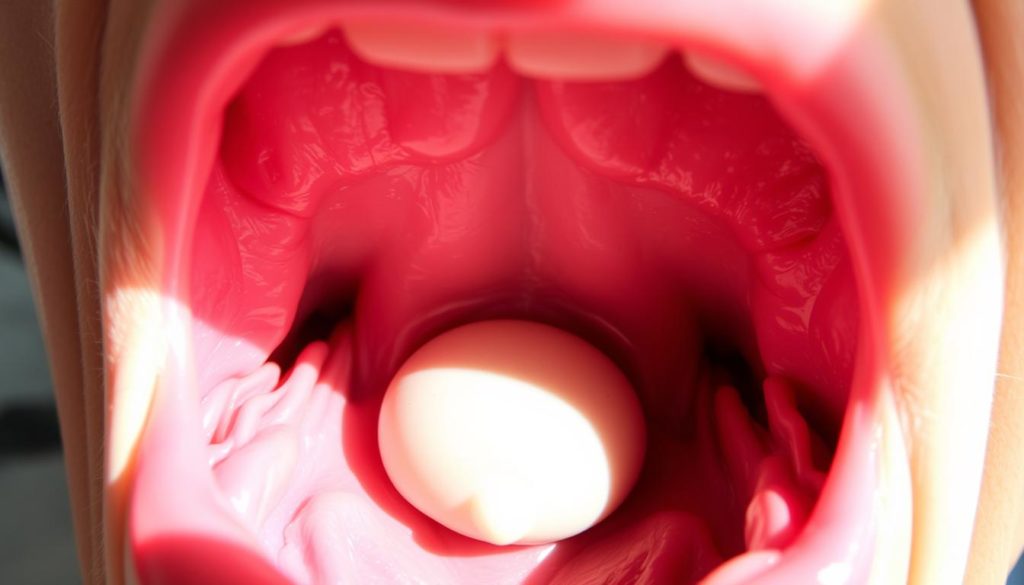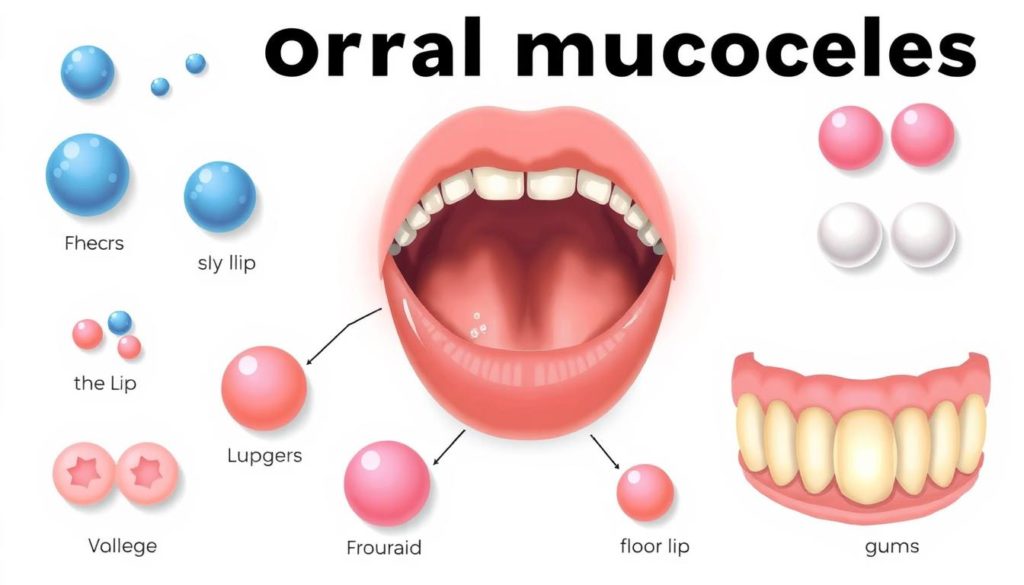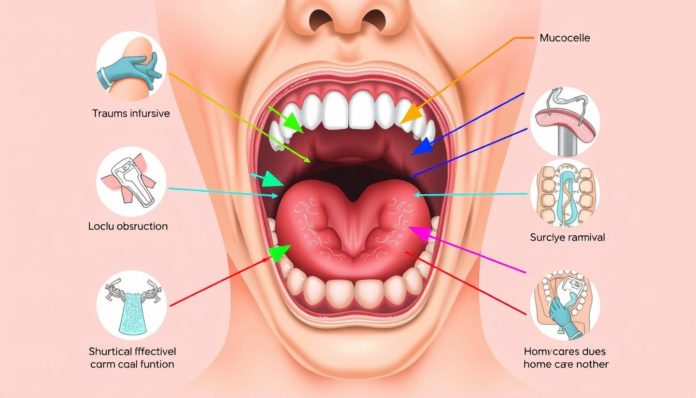Did you know a lot of people, up to 30%, will get an oral mucous cyst in their life? This fact shows why knowing about mucoceles is important for keeping your mouth healthy. They often come from injuries or clogged salivary glands and can be annoying. It’s key to spot their symptoms early and figure out how to treat them.
A mucocele looks like a fluid-filled bubble in your mouth. It can make eating and talking hard. Learning why they happen, like from an injury or blocked salivary glands, is the first step. Then, it’s about finding the best cure, which could be home treatments or seeing a doctor for surgery or lasers.
Keep reading to understand mucoceles better. Find out about their growth and how to deal with and stop them. By doing this, you can keep your mouth health in great shape.
What is a Mucocele?
An oral mucocele is a fluid-filled swelling often found in the lower lip. It can also appear on the mouth floor or other mouth areas. These swellings, known as mucous cysts, pop up due to a blocked or burst salivary gland duct.

Definition and Overview
A mucocele, or mucous cyst, is a fluid-filled lump that feels like a dome. It usually comes from hurting the inside of your mouth, like biting your lip or cheek by accident. This causes a salivary gland to get blocked or hurt. While they’re mostly not harmful and don’t hurt, their size and where they are can make them uncomfortable.
Common Symptoms
Oral mucoceles show up as a lump or swelling, which can change size. They can make talking, chewing, or swallowing feel weird. You might also see a bluish color and feel soreness if you touch it.
Types of Oral Mucoceles
Oral mucoceles differ by their spots in the mouth and the glands affected. Knowing these types helps in spotting and treating them properly. Mainly, there are the minor salivary gland mucocele and the ranula.
Minor Salivary Gland Mucoceles
Minor salivary gland mucoceles are the most seen mucoceles. They pop up anywhere there’s saliva, like the lips, cheeks, and mouth floor. They look like small, painless bumps filled with mucus. Even if not harmful, their place and feeling can still be annoying.
Ranulas
Ranulas are specific mucoceles found on the mouth’s floor. They’re bigger than the minor ones and can bother you more. They happen when the sublingual gland gets blocked, causing saliva to gather and make a big bump. Because of their size and place, ranulas can make talking, eating, and just feeling okay in your mouth hard.

The differences between a minor salivary gland mucocele and a ranula stands out a lot:
| Type | Location | Size | Symptoms |
|---|---|---|---|
| Minor Salivary Gland Mucocele | Anywhere in the mouth | Small | Painless swelling |
| Ranula | Floor of the mouth | Larger | Discomfort, speech, and eating interference |
Causes of Mucoceles
Mucoceles can form for many reasons. They might occur because of mouth injuries or when salivary glands are blocked. Knowing why they happen is key to stopping them early on.
Trauma and Injury
One major cause of mucocele causes is trauma in the mouth area. This can happen from lip biting, wearing braces, or piercing the mouth. These actions can damage the small saliva glands, causing mucoceles.
Obstruction of Salivary Glands
Another big reason for mucoceles is when saliva ducts get blocked. Stuff like mucus plugs or stones can stop them up. When saliva can’t move right, mucoceles may form in your mouth.
| Cause | Description |
|---|---|
| Trauma | Injury from lip biting, braces, or piercings. |
| Salivary Gland Obstruction | Blockage from mucus plugs or stones. |
Diagnosis of a Mucocele
Diagnosing a mucocele correctly is key to treat and manage it well. It starts with a detailed clinical examination. This is followed by special imaging tests to confirm a mucocele’s presence and shape.
Clinical Examination
During the exam, doctors look closely at where the cyst is and what it looks like. They check the mucocele’s size, color, and texture. A patient’s health history is also important. It helps doctors tell mucoceles apart from other mouth sores.
Imaging Techniques
Imaging tests like ultrasound and MRI help understand the mucocele better. Ultrasounds show the cyst’s fluid nature and its effect on deep tissue. MRIs give clear images of where the cyst ends and if it’s blocking anything. Using these imaging tests, doctors can diagnose mucoceles with high accuracy.
Common Symptoms of a Mucocele
Knowing the common mucocele symptoms is key to spotting them early. Often, you’ll see a small, fluid-filled bump inside your mouth. It’s usually on the inner lips or under the tongue. This bump can look bluish or almost see-through, which sets it apart from other mouth tissues.
The signs in your mouth from a mucocele can include feeling uncomfortable in that spot. It might just irritate you or hurt more seriously. These issues can make eating and talking hard, pushing people to get help.
Sometimes, a mucocele’s size changes, getting bigger or smaller at different times. This unpredictability can be especially bothersome. It underlines why seeing a doctor is wise if these problems don’t go away.
| Symptom | Description |
|---|---|
| Fluid-Filled Nodule | A small, raised bump often resembling a blister, commonly found on the inner lips or under the tongue. |
| Bluish/Translucent Coloration | The nodule may have a distinct bluish hue or may appear clear, differentiating it from surrounding tissues. |
| Discomfort | The area may feel tender, irritated, or painful, especially when eating or speaking. |
| Size Fluctuation | The mucocele may vary in size, sometimes growing larger or smaller over days or weeks. |
These mucocele symptoms show why paying attention to your mouth is crucial. Quick action ensures proper care and handling.
When to See a Doctor
It’s key to know when to see a doctor for a mucocele. Acting fast helps stop bigger problems and keeps your mouth’s health in top shape.
Persistent Symptoms
If a mucocele doesn’t go away after a few weeks, get medical help. If it keeps swelling, hurts, or makes eating or talking hard, you need to check with a doctor. This helps stop more issues from happening.
Complications
Not treating mucoceles can cause them to keep breaking open, lead to ongoing pain, and infections. It’s vital to watch out for these troubles. See a doctor if they happen to avoid long-term harm and pain.
Mucocele Treatment Options
When dealing with a mucocele, you have options to ease the discomfort. We will explore both home care and medical treatments. This way, you can find a comprehensive approach to handling your mucocele.
Home Remedies
Starting with home remedies can be a gentle way to manage mucoceles. Here are some simple steps:
- Saltwater Rinses: Rinsing with warm saltwater helps lower inflammation and aids healing.
- Ice Application: Ice can numb the area, reducing pain and swelling.
- Avoiding Irritants: Stay away from spicy or acidic foods to avoid making it worse.
Trying these home remedies is a good first move. They can relieve pain and help heal naturally.
Medical Interventions
When home remedies aren’t enough, it might be time for medical help. There are a few ways doctors can treat mucoceles:
| Type of Medical Intervention | Description |
|---|---|
| Corticosteroid Injections | These shots reduce inflammation and make the mucocele smaller. |
| Cryotherapy | This method freezes the mucocele, causing it to disappear over time. |
| Complete Excision | This minor surgery removes the mucocele completely. |
Choosing the right medical treatment depends on how bad your mucocele is. It’s important to talk to a doctor to find the best treatment for you.
Mucocele Removal Procedures
Two main methods help remove mucoceles: surgical removal and laser therapy. Both can ease discomfort and prevent further issues. The best choice depends on the person’s situation and the doctor’s advice.
Surgical Removal
Surgical removal is a proven method. It involves marsupialization or excision. Marsupialization opens the mucocele and stitches it to drain. Excision cuts the mucocele out fully.
This surgery usually uses local anesthesia and may not require a hospital stay. Healing takes a few weeks. Good care after surgery is crucial to avoid infection and heal well.
Laser Therapy
Laser therapy is a newer, less invasive way. It uses lasers to target and remove the mucocele. It leaves smaller scars and heals quicker than surgery.
Done with local anesthesia, it causes less bleeding and swelling. People often get back to daily life quickly. Laser therapy also has a lower chance of the mucocele coming back.
| Mucocele Removal Method | Key Features | Advantages |
|---|---|---|
| Surgical Removal | Marsupialization or Excision | Well-established; effective |
| Laser Therapy | Use of concentrated light beams | Minimal scarring; faster recovery |
Prevention of Mucoceles
Stopping mucoceles means keeping your mouth healthy and avoiding mouth injuries. Here are some key tips for stopping mucoceles.
Good Oral Hygiene Practices
Keeping your mouth clean is crucial to stop mucoceles. Brush and floss regularly to fight bacteria. This keeps your salivary glands working right.
Using an antiseptic mouthwash also helps prevent infections that could cause mucoceles.
- Brush your teeth twice a day with fluoride toothpaste.
- Floss daily to remove food particles and plaque from between your teeth.
- Use an antiseptic mouthwash to maintain overall oral health.
Trauma Avoidance
Avoiding mouth injuries is also key to stopping mucoceles. Be careful when eating hard foods. Avoid biting your lips or cheeks, and be cautious with oral piercings.
- Chew food slowly and carefully to prevent accidental biting.
- Be mindful of habits like chewing on pens or your nails as they can lead to trauma.
- If you have oral piercings, ensure they are properly maintained and not causing undue friction or injury to your mouth’s soft tissues.
Impact on Daily Life
Mucoceles can change how you live every day, especially due to the discomfort. They make routine activities like eating, drinking, and talking hard. Knowing how they affect you shows why getting treatment early is key to feeling better.
Eating and Drinking
Eating can be tough when you have a mucocele. It can hurt to chew and swallow, making meal times not fun. Also, mucoceles can make your mouth sensitive to hot or cold foods, making eating tricky. Drinking beverages, especially if they’re hot or acidic, can also hurt.
Speaking and Comfort
Mucoceles can affect how well you talk. They might make you slur your words or have trouble saying them. This is a big deal in social and work situations where you need to be clear. Moreover, mucoceles can make you uncomfortable all the time. Treating them not only fixes these problems but also improves your overall comfort. This makes everyday things easier and more enjoyable.
FAQ
What is a mucocele?
A mucocele is a fluid-filled lump that happens in the mouth. It appears mainly on the lower lip or mouth floor. These lumps form when a salivary gland duct gets blocked or ruptures.
What are common symptoms of a mucocele?
You might notice a lump that could be bluish. It can bother you when you talk, chew, or swallow. Even though it’s usually not painful, it can still be annoying.
What causes mucoceles?
Mucoceles come from hurting the mouth or blocking salivary glands. This can be from biting lips or from piercings. They can also start from mucus plugs or stones blocking glands.
How are mucoceles diagnosed?
Doctors look at the cyst and take your medical history to diagnose mucoceles. They might use an ultrasound or MRI to see it better.
When should I see a doctor about a mucocele?
Go to a doctor if your mucocele stays too long or hurts a lot. You should also go if it keeps breaking or if it gets infected. Getting help early can stop more problems.
What are the treatment options for mucoceles?
You can try simple things like rinsing with salt water or not irritating it. For worse cases, treatments include shots, freezing it, or cutting it out.
How are mucoceles removed?
Doctors can remove mucoceles by cutting them out or using special techniques. Laser therapy is good because it leaves smaller scars and heals faster.
Can mucoceles be prevented?
Yes, keeping your mouth clean and not hurting it can prevent mucoceles. Be careful when eating, don’t bite your lips, and think carefully about mouth piercings.


